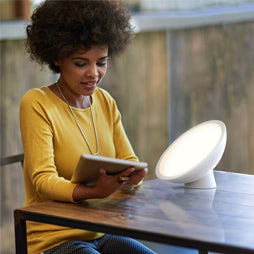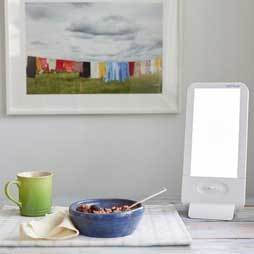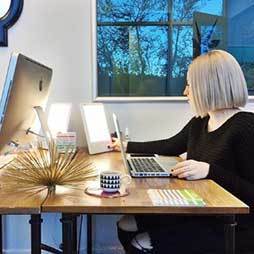Light Therapy for Sleep Disorders
Desperately Seeking Sleep? Go from Light To Dark!
The disruption of our circadian body clock (the clock that regulates our sleep & wake cycle) is caused by exposure to light at the wrong time of day. The fact is our bodies were engineered long ago to be hunter-gatherers – meaning our activity would rise and rest with the cycle of the sun. But our lifestyles have changed since then, and now we have light in our lives well after sunset.
HappyLight by Verilux is the natural solution to insomnia or the inability to fall asleep until very late at night due to circadian rhythm issues. This common condition known as Delayed Sleep Phase Syndrome is a circadian sleep disorder in which your circadian rhythm gets pushed back further and further into the A.M.

Circadian Rhythm Sleep Disorders & Delayed Sleep Phase Syndrome

Modern lighting conditions with bright, blue light screens of cell phones, tablets and laptops imitate the stimulating effects of the sun. When used habitually, this messes with our brain’s chemistry and makes it difficult for it to regulate our sleep.
Here's the science behind it: The blue wavelengths contained in sunlight react with melanopsin receptors in our retinas. This halts the production of the sleep hormone melatonin. It is why blue wavelength light (mostly from digital screens) at night can push back the circadian rhythm and cause Delayed Sleep Phase Syndrome and other forms of insomnia.
According to several studies, blue wavelengths can actually block up to 99% of melatonin production and delay melatonin onset for an average of 90 minutes.†
Get a HappyLight for a Happy Night
Darkness stimulates the production of the sleep hormone melatonin, so limiting screen time at night is helpful. But it’s also important to get plenty of natural light during the daytime - this is an essential part of regulating your body clock. Regular indoor lighting is no substitute; it is not bright enough to have the stimulating effect our bodies require in the morning.
Daily morning exposure to bright light is the most successful means of shifting one’s sleep schedule. While taking advantage of 30 minutes of sunlight exposure is an appealing idea, our work schedules, seasonal changes, and weather conditions do not always allow for this.
Bright light therapy is a substitute for the sun and a successful treatment to reset your circadian clock with regular use. It is also a healthy, drug-free alternative to solving sleep disorders. The HappyLight provides the necessary intensity of 10,000 lux light that is free of harmful UV rays.

How HappyLight Helps With Sleep
I have a circadian sleep disorder which screws up my sleeping. Using this lamp for 20-30 minutes first thing in the morning after I get up allows me to get into bed and fall asleep at night on time and much better than before it.
-Millie
I am quite happy that this light works so well. After I began using it I have been able to get to sleep at night and can wake up more easily in the morning. I generally feel better and have more energy.
-Paul
I wasn’t sure at first that this light would do what I needed to help with my sleep pattern but so far I have been very happy. The best thing I have found is that is seemed to completely reset my sleep cycle. I used to lay in bed and feel exhausted but not able to fall asleep. After a week of using the light I began being able to get to sleep in a regular amount of time, which has been amazingly helpful. If you have had crippling sleep issues like me, going weeks at a time without sound sleep, this product will help.
-Jon
More Information about Light & Light Box Therapy
* Chart statistic source: National Sleep Foundation
† See Zeitzer, 2000; Duffy, J.F. & Czeisler, 2009; Gooley, 2011





